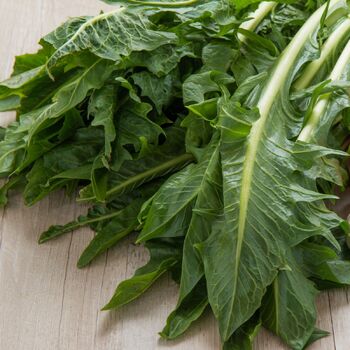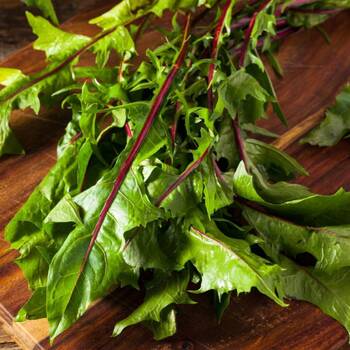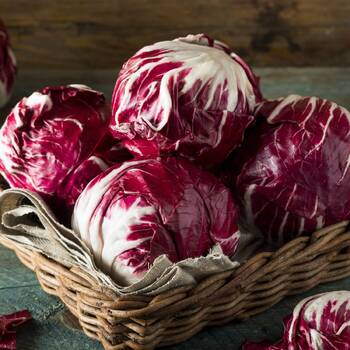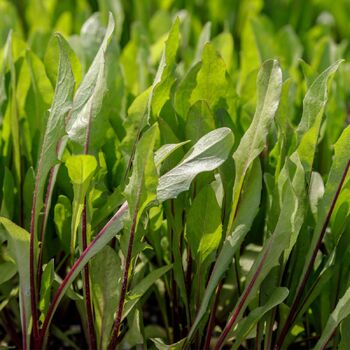
How to Grow Chicory (Radicchio) Seeds
Grow Guide #2249
Family: Asteraceae
Binomial name: Cichorium intybus
Life Cycle: Perennial
This 'How to Grow' guide details everything a home gardener needs to know to plant, grow and care for Chicory (Cichorium intybus).
Chicory can be grown with the aim of harvesting loose leaves, tightly packed hearts or roots. Witloof, a form of chicory, can also be 'forced' to produce tender chicons (tightly packed new leaves that are grown in the dark). This guide explains how to grow chicory for its leaves, hearts and roots. To learn how to grow witloof, click here.
When to Sow Chicory Seeds
Chicory is a cool season crop. Use the table below to identify the best time of year to sow chicory in your climate.
| JAN | FEB | MAR | APR | MAY | JUN | JUL | AUG | SEP | OCT | NOV | DEC | |
|---|---|---|---|---|---|---|---|---|---|---|---|---|
| Cool | ||||||||||||
| Temperate | ||||||||||||
| Sub-Tropical | ||||||||||||
| Tropical | ||||||||||||
| Arid |
Preparation
Chicory plants are best grown in full sun. Choose a location that will receive at least 6 hours of full sun each day.
Chicory plants need a well drained soil enriched with plenty of organic matter. Prepare soil by weeding it thoroughly, digging it over to loosen it and adding aged animal manure or compost. Keep the area free of weeds until planting. Learn more about preparing soil for planting here.
Chicory plants can be grown in containers. If possible choose a variety that’s recommended for container growing. Use a good quality potting mix and make sure your container is large enough for mature plants; a minimum of 40 litres is recommended for chicory. During the growing season, keep in mind that container grown plants may need additional fertiliser to encourage healthy growth.
How to Sow Chicory Seeds
Chicory seeds do not require any treatment (eg soaking, stratification) before sowing.
Chicory seeds grow best when they are sown directly into the garden.
- Sow seeds directly in the garden 5mm deep and 20cm apart, with rows 30cm apart.
- Keep soil moist but never wet or dry.
- Seeds should germinate in around 4-10 days at a soil temperature of 15-18°C.
- Young seedlings will need protection from pests, pets and weather until they are established.
How to Grow Chicory
Chicory plants may need watering during the growing season. Water when the soil is dry about 5cm below the surface (test this by scratching away a little soil with your finger). Water deeply in the early morning or late afternoon. Avoid watering the leaves of plants to avoid fungal diseases. Learn more about watering here.
If soil was well prepared no extra fertiliser should be necessary. In poor soil or to give your plants an extra boost, application of a high-nitrogen fertiliser or one formulated for leafy greens or herbs can be beneficial:
- Apply slow release fertiliser at the recommended rate when transplanting or when seedlings are 5-10cm tall.
- Apply liquid fertiliser at the recommended rate and frequency during the growing season.
How to Harvest Chicory
Chicory should be ready to harvest in approximately 50-65 days.
Loose leaves are ready to harvest when they are large enough to eat, and can be harvested as needed. Harvest leaves by cutting off the outer ones at the base, leaving some on the plant for future growth. Whole plants can also be harvested by cutting the plant just above soil level. Chicory leaves should be eaten soon after harvest. Leaves can be stored short term in a perforated plastic bag in the fridge.
Hearts are ready to harvest when a small head has formed at the centre of the plant once it has reached its mature size. Harvest by cutting the whole plant just above soil level and discarding the outer leaves. Chicory hearts can be stored short term in a perforated plastic bag in the fridge. For longer term storage chicory hearts can be pickled.
Roots are ready to harvest when the plant has grown to full size. Harvest the tap roots using a shovel to uproot the entire plant. Prune off all the foliage and use a hose to clean excess soil off the roots. For long term storage chicory roots can be peeled or chopped then dried, roasted and ground before being stored in an airtight container.
Common Problems when Growing Chicory
Like all plants, chicory is susceptible to some pests, diseases and other problems. Below is a list of the most common problems gardeners encounter when growing chicory plants:
 Aphids are small (2-4mm long) sap-sucking insects that congregate on the new shoots or the undersides of leaves. They can cause leaves to wilt or become discoloured, and also excrete honeydew which can attract ants and other insect pests. To manage aphids, remove them by spraying with a garden hose, apply a soap or alcohol spray, or encourage predatory insects to your garden. Read more about aphids here.
Aphids are small (2-4mm long) sap-sucking insects that congregate on the new shoots or the undersides of leaves. They can cause leaves to wilt or become discoloured, and also excrete honeydew which can attract ants and other insect pests. To manage aphids, remove them by spraying with a garden hose, apply a soap or alcohol spray, or encourage predatory insects to your garden. Read more about aphids here. Bitter taste can be caused by plants growing too slowly, suffering a setback in growth or being harvested too late. Enrich soil with aged manure before planting, ensure plants are watered deeply and regularly, and harvest when they are young and tender.
Bitter taste can be caused by plants growing too slowly, suffering a setback in growth or being harvested too late. Enrich soil with aged manure before planting, ensure plants are watered deeply and regularly, and harvest when they are young and tender. Downy mildew is a fungal disease that causes yellow to grey-brown patches on leaves, especially the undersides. Water plants at soil level (not on the leaves), remove and destroy affected leaves and do not overcrowd plants to ensure adequate air flow. If problems persist, spray with a homemade milk spray or fungicide.
Downy mildew is a fungal disease that causes yellow to grey-brown patches on leaves, especially the undersides. Water plants at soil level (not on the leaves), remove and destroy affected leaves and do not overcrowd plants to ensure adequate air flow. If problems persist, spray with a homemade milk spray or fungicide. Heads not forming is usually caused by warm weather or by growing plants too slowly, without adequate water or nutrients. Check to make sure you are growing a head-forming type of chicory. In warm climates, grow chicory in autumn and spring to avoid extreme temperatures. Water regularly and ensure adequate compost or fertiliser is applied.
Heads not forming is usually caused by warm weather or by growing plants too slowly, without adequate water or nutrients. Check to make sure you are growing a head-forming type of chicory. In warm climates, grow chicory in autumn and spring to avoid extreme temperatures. Water regularly and ensure adequate compost or fertiliser is applied. Slugs and snails are molluscs that feed on tender leaves and shoots, mostly at night, leaving slimy trails behind them. Control them by removing their hiding places, keeping free range poultry, collecting them by torchlight or by placing traps. Read more about slugs and snails here.
Slugs and snails are molluscs that feed on tender leaves and shoots, mostly at night, leaving slimy trails behind them. Control them by removing their hiding places, keeping free range poultry, collecting them by torchlight or by placing traps. Read more about slugs and snails here.


.png)






